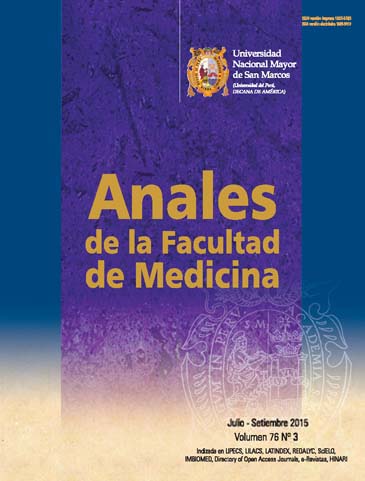Use of genotoxic markers for the evaluation of farmers exposed to organophosphorous pesticides
DOI:
https://doi.org/10.15381/anales.v76i3.11233Keywords:
Insecticides, Organophosphate, Serum cholinesterase, Erythrocyte cholinesterase, Comet assay, Micronuclei, Chromosomal aberrations.Abstract
Introduction: Organophosphorous pesticides are compounds used to control pests in agricultural activities. They generate potential occupational exposure associated with acute and chronic poisoning manifested by biochemical, molecular and genetic alterations that may be assessed using genotoxic markers. Objective: To evaluate genotoxicologic markers use for assessing farmers exposed to organophosphate pesticides. Design: Observational, analytical, cross-sectional study with control group. Institution: Asparagus Agro Exportation Company in District of Virú, La Libertad. Interventions: Enzyme activity of serum (BChE) and erythrocyte cholinesterase (AChE), and genotoxicity assays (chromosome aberrations, comet assay and micronucleus) were assessed in 59 workers exposed to pesticides (exposed group) and 50 individuals not exposed to pesticides (control group). Main outcome measures: Enzyme activity of serum (BChE) and erythrocyte cholinesterase (AChE), and genotoxicity assays (chromosome aberrations, comet assay and micronucleus). Results: Average age of the exposed and control groups were respectively 39.6 ± 10.8 and 34.0 ± 11.5 years. Referring to BChE activity, significant difference (p <0.001) was found between the exposed group (4733.0 ± 1350.1 U/L) and control group (7075.0 ± 1674.0 U/L). The contrary occurred in the AChE activity between the exposed (4867.0 ± 632.2 U/L) and control group (5051.0 ± 505.5 U/L). Furthermore, there was evident inhibition of both enzymes below the reference value in 9 workers. No significant difference was observed in genotoxic markers, except for buccal epithelium cells micronuclei count, nucleoplasmic bridges, buddings, binucleation and karyorrhexis. In comet assay DNA damage evaluation (p <0.05) mean queue intensity was 8.28 ± 1.85 (range: 6.06- 15.75) and 7.30 ± 1.25 (range: 4.04-9.41) for the exposed and control groups, respectively. Conclusions: Use of genotoxicologic markers provided relevant information to predict cnacer-associated risk considering the initial event is damage to deoxyribonucleic acid (DNA) at any stage of the cell cycle. Significant association between genotoxic effects and exposure to organophosphorous pesticides was demonstrated by BChE inhibition.Downloads
Published
2015-09-30
Issue
Section
Artículo Original
License
Copyright (c) 2015 Jaime Rosales

This work is licensed under a Creative Commons Attribution-NonCommercial-ShareAlike 4.0 International License.
Those authors who have publications with this magazine accept the following terms:
- Authors will retain their copyrights and guarantee the journal the right of first publication of their work, which will be simultaneously subject to Creative Commons Attribution License that allows third parties to share the work as long as its author and its first publication this magazine are indicated.
- Authors may adopt other non-exclusive licensing agreements for the distribution of the version of the published work (eg, deposit it in an institutional electronic file or publish it in a monographic volume) provided that the initial publication in this magazine is indicated.
- Authors are allowed and recommended to disseminate their work over the Internet (eg: in institutional telematic archives or on their website) before and during the submission process, which It can produce interesting exchanges and increase quotes from the published work. (See El efecto del acceso abierto ).
How to Cite
1.
Rosales J. Use of genotoxic markers for the evaluation of farmers exposed to organophosphorous pesticides. An Fac med [Internet]. 2015 Sep. 30 [cited 2024 Jul. 17];76(3):247-52. Available from: https://revistasinvestigacion.unmsm.edu.pe/index.php/anales/article/view/11233















